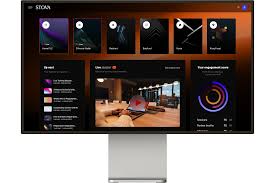The world has changed dramatically over the past year, with the COVID-19 pandemic forcing businesses to adapt to new ways of operating. One of the most significant changes has been the shift from physical events to virtual ones, including trade shows. As a result, virtual trade show platforms have become increasingly popular and essential for businesses looking to connect with customers and prospects.
A virtual trade show platform is an online platform that allows businesses to host a trade show virtually. These platforms provide a range of features, including virtual booths, live chat capabilities, webinars, and networking opportunities. Attendees can access these events from anywhere in the world, using their computers or mobile devices.
One of the most significant benefits of a virtual trade show platform is its accessibility. Traditional trade shows can be expensive and time-consuming for both exhibitors and attendees. Virtual events eliminate travel costs and time constraints, making it easier for attendees to participate in multiple events in a short period.
Another advantage of virtual trade shows is their flexibility. Exhibitors can customize their booths with interactive features such as videos, product demos, and downloadable content. Attendees can explore these booths at their own pace and interact with representatives through live chat or video calls.
Virtual trade shows also provide valuable data insights that are not available at physical events. Organizers can track attendee engagement levels, booth traffic patterns, and other metrics that help them optimize future events.
Of course, there are some downsides to virtual trade shows. The lack of face-to-face interaction may make it harder for exhibitors to build personal relationships with potential customers or partners. Additionally, technical issues such as poor internet connectivity could impact attendee experiences.
Overall though, virtual trade show platforms offer a cost-effective and accessible way for businesses to connect with customers and prospects from around the world. As we continue to navigate through this pandemic era, it’s likely that we’ll see more companies embracing this new way of doing business.
9 Tips for Maximizing Your Virtual Trade Show Presence
- Utilize the platform’s features to promote your brand and products.
- Use engaging visuals such as videos, graphics, and photos to attract visitors.
- Set up a virtual booth with information about your business, products, services, and contact information.
- Create special offers or discounts for attendees who visit your booth during the show.
- Offer interactive experiences such as Q&A sessions or product demos for attendees to engage with you and learn more about what you offer.
- Leverage social media platforms to advertise your virtual trade show presence and drive traffic to your booth page on the platform’s website or app.
- Connect with other exhibitors in order to build relationships that will benefit both of you in the long run by exchanging ideas and resources related to marketing strategies for virtual trade shows
- Stay organized by using a checklist of tasks that need to be completed before, during, and after the show in order to ensure everything goes smoothly
- Provide feedback surveys at the end of each show so that you can better understand how successful it was and what improvements should be made for future events
When participating in a virtual trade show, it’s crucial to utilize the platform’s features to promote your brand and products effectively. Virtual trade show platforms offer many interactive features that can help you stand out and attract potential customers.
One of the essential features to utilize is your virtual booth. Customize your booth with eye-catching graphics, videos, and product demos that showcase your brand and products. Make sure to include clear calls-to-action that encourage attendees to engage with you further.
Another feature to leverage is live chat capabilities. Use this feature to connect with attendees in real-time, answer their questions, and build relationships. Make sure to have knowledgeable representatives available during the event who can provide valuable insights into your products or services.
Webinars are also an effective way to promote your brand and products on virtual trade show platforms. Host a webinar that provides attendees with valuable information about your industry or product offerings. Make sure to include a Q&A session at the end of the webinar so attendees can ask questions and engage with you further.
Finally, don’t forget about networking opportunities provided by the virtual trade show platform. Connect with other exhibitors or attendees who may be interested in partnering with you or learning more about your business.
In conclusion, utilizing all the features provided by a virtual trade show platform is crucial if you want to promote your brand and products effectively. With careful planning and execution, you can use these features to create engaging experiences that will attract potential customers and help grow your business.
Use engaging visuals such as videos, graphics, and photos to attract visitors.
When it comes to virtual trade show platforms, the competition for attention can be fierce. With so many booths and exhibits vying for visitors’ attention, it’s essential to make your booth stand out. One of the best ways to do this is by using engaging visuals such as videos, graphics, and photos.
Visuals are a powerful tool for attracting visitors to your booth. They capture people’s attention and can communicate information quickly and effectively. Videos, for example, allow you to showcase your products or services in action, providing a more immersive experience than text or images alone.
Graphics and photos can also be effective in communicating your brand message and creating an attractive booth design. They can help convey complex ideas or data in a visually appealing way that’s easy for visitors to understand.
However, it’s important not to go overboard with visuals. While they can be eye-catching, too many graphics or videos can overwhelm visitors and make your booth appear cluttered. It’s crucial to strike a balance between engaging visuals and an organized layout that allows visitors to navigate your booth easily.
In summary, using engaging visuals such as videos, graphics, and photos is an excellent way to attract visitors to your virtual trade show platform booth. By creating an attractive design that communicates your brand message effectively, you’ll stand out from the competition and increase the chances of making valuable connections with potential customers or partners.
When it comes to virtual trade shows, setting up a virtual booth is essential. Your virtual booth is your online storefront, and it’s the first thing attendees will see when they enter the event. It’s crucial to make a great first impression by providing valuable information about your business, products, and services.
To set up a successful virtual booth, start by creating a visually appealing design that represents your brand. You can use graphics, images, and videos to showcase your products or services. Make sure that the design is consistent with your website and other marketing materials.
Next, provide detailed information about your business and what you offer. Explain how your products or services can help attendees solve their problems or meet their needs. Use clear language and avoid industry jargon that may be confusing to those who are not familiar with your industry.
Include contact information so that attendees can easily get in touch with you. This could include an email address, phone number, or a link to schedule a meeting or demo. Make sure that all links are working correctly and that someone on your team is available to respond promptly to any inquiries.
Finally, consider adding interactive features such as live chat or video conferencing capabilities to allow attendees to connect with representatives from your company in real-time. This will help build personal relationships with potential customers and partners.
Setting up a virtual booth may seem daunting at first, but it’s an excellent opportunity for businesses of all sizes to showcase their offerings on a global stage. By following these tips and investing time in creating an engaging virtual booth, you’ll increase the chances of attracting new customers and making meaningful connections at virtual trade shows.
Create special offers or discounts for attendees who visit your booth during the show.
If you’re planning to participate in a virtual trade show, one of the best ways to attract and engage attendees is by offering special deals or discounts. By offering exclusive promotions, you can encourage visitors to your booth and increase your chances of generating leads and sales.
Creating special offers or discounts for attendees is a great way to stand out from other exhibitors and capture their attention. You can offer discounts on your products or services, free trials, or even giveaway prizes for those who visit your booth during the show.
To make the most of this strategy, it’s essential to promote your offers before the event starts. You can use social media platforms, email marketing campaigns, or even targeted ads to let attendees know about your promotions. This will help build anticipation and excitement around your booth before the event starts.
During the event, make sure that your offers are prominently displayed on your virtual booth. Use eye-catching graphics and clear messaging to communicate what visitors can expect from your promotions. You can also use chatbots or live chats to answer any questions that attendees may have about the deals.
Finally, don’t forget to follow up with leads after the event ends. Use email marketing campaigns or personalized messages to remind attendees about your offers and encourage them to take advantage of them before they expire.
In conclusion, creating special offers or discounts for attendees is an effective way to drive traffic to your virtual trade show booth. By promoting these deals before the event starts and making them visible during the show, you can attract more visitors and generate more leads for your business.
Offer interactive experiences such as Q&A sessions or product demos for attendees to engage with you and learn more about what you offer.
When it comes to virtual trade shows, engaging with attendees is key. One way to do this is by offering interactive experiences such as Q&A sessions or product demos. These experiences allow attendees to learn more about your company and what you offer in a more personalized and engaging way.
Q&A sessions are an excellent way to connect with attendees and answer any questions they may have about your products or services. By providing a platform for discussion, you can build trust and credibility with potential customers and show them that you care about their needs.
Product demos are another effective way to engage with attendees. By showcasing your products in action, you can demonstrate their features and benefits in a more tangible way. This can help attendees understand how your products can solve their problems or meet their needs.
Offering interactive experiences also provides an opportunity for attendees to provide feedback and share their thoughts on your products or services. This feedback can be valuable in helping you improve your offerings or identify areas for growth.
Overall, offering interactive experiences such as Q&A sessions or product demos is a great way to engage with attendees at virtual trade shows. By providing personalized experiences, you can build relationships with potential customers and show them why your company is the right choice for their needs.
Leverage social media platforms to advertise your virtual trade show presence and drive traffic to your booth page on the platform’s website or app.
If you’re planning to participate in a virtual trade show, one of the most important things you can do is to leverage social media platforms to advertise your presence. With so many people spending time on social media, it’s an excellent way to reach a wider audience and drive traffic to your booth page on the virtual trade show platform.
Start by identifying which social media platforms your target audience is most active on. It could be Facebook, Twitter, LinkedIn, or Instagram. Once you have identified these platforms, create posts that promote your participation in the virtual trade show. Use eye-catching visuals and clear messaging that highlights what attendees can expect from your booth.
In addition to promoting your participation, use social media to share updates about any products or services you will be showcasing at the event. You could also offer special promotions or discounts for attendees who visit your booth during the virtual trade show.
Another effective strategy is to use hashtags related to the event and industry in your posts. This will help potential attendees discover your brand and booth page when they search for those hashtags.
Finally, consider partnering with other exhibitors or industry influencers on social media. This will allow you to reach a wider audience and increase visibility for all parties involved.
In summary, leveraging social media platforms is an excellent way to promote your presence at a virtual trade show and drive traffic to your booth page on the platform’s website or app. By creating engaging content and using relevant hashtags, you can attract more attendees and make the most out of this exciting opportunity.
When it comes to virtual trade shows, building relationships with other exhibitors can be just as important as connecting with potential customers. By collaborating and exchanging ideas and resources related to marketing strategies for virtual trade shows, you can create a network of support that benefits everyone involved.
One way to connect with other exhibitors is by attending virtual networking events or joining online communities specific to your industry or niche. These events and groups provide opportunities to meet other exhibitors, share experiences, and discuss best practices for successful virtual trade shows.
Collaborating with other exhibitors can also help you expand your reach by cross-promoting each other’s products or services. For example, if you’re exhibiting at a virtual trade show and another company has a complementary product or service, you could partner up and promote each other’s offerings through joint webinars or social media campaigns.
In addition to networking and cross-promotion, sharing resources such as marketing materials or tips for creating engaging virtual booths can also benefit both parties. By exchanging ideas and learning from each other’s successes (and failures), you can improve your own marketing strategies and increase your chances of success at future events.
Overall, connecting with other exhibitors is an essential aspect of building relationships that will benefit everyone in the long run. By collaborating and sharing resources related to marketing strategies for virtual trade shows, you can create a supportive network that helps everyone achieve their goals.
Stay organized by using a checklist of tasks that need to be completed before, during, and after the show in order to ensure everything goes smoothly
Virtual trade shows offer businesses a unique opportunity to connect with customers and prospects from around the world. However, organizing a successful virtual event can be challenging, especially if you’re not accustomed to this new way of doing business. That’s why it’s essential to have a checklist of tasks that need to be completed before, during, and after the show.
Before the show, make sure you have everything in place. This includes setting up your virtual booth, creating engaging content such as videos and product demos, and promoting your participation on social media platforms. You should also test your internet connection and make sure all your equipment is working correctly.
During the show, stay organized by keeping track of attendee engagement levels and booth traffic patterns. Be available for live chats or video calls with attendees who want to learn more about your products or services. Take notes on any questions or concerns that come up during these conversations so you can follow up with attendees later.
After the show, it’s essential to follow up with leads promptly. Send personalized emails thanking attendees for visiting your booth and providing them with additional information about your products or services. Review any data insights from the event to evaluate what worked well and what needs improvement for future events.
By using a checklist of tasks that need to be completed before, during, and after the show, you can ensure everything goes smoothly. Staying organized will help you make the most of your virtual trade show platform experience and enable you to connect with potential customers in a meaningful way.
Provide feedback surveys at the end of each show so that you can better understand how successful it was and what improvements should be made for future events
Virtual trade shows have become increasingly popular in recent times, and for a good reason. They offer a cost-effective and accessible way for businesses to connect with customers and prospects from around the world. However, organizing a virtual trade show can be challenging, and it’s important to understand how successful it was and what improvements should be made for future events.
One of the best ways to gather feedback is by providing surveys at the end of each show. These surveys can help you understand what attendees liked or disliked about the event, what worked well, and what could be improved. This feedback can be invaluable in helping you plan future events that are even more successful.
When creating your survey, make sure to ask open-ended questions that allow attendees to provide detailed feedback. For example, instead of asking whether they enjoyed the event or not, ask them what they liked or didn’t like about it. You can also ask specific questions about things like the quality of presentations or ease of navigation.
It’s also essential to make sure that your survey is easy to complete. Keep it short and straightforward so that attendees are more likely to take the time to provide feedback. Additionally, offering incentives such as discounts or prizes for completing the survey can motivate attendees to participate.
In conclusion, providing feedback surveys at the end of each virtual trade show is an excellent way to gather valuable insights into how successful your event was and what improvements should be made for future events. By taking this step, you’ll be able to create even better virtual trade shows that meet the needs of your customers and prospects while driving business growth.





